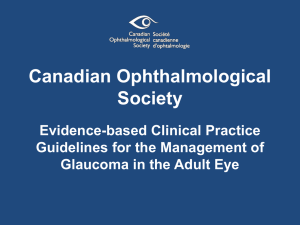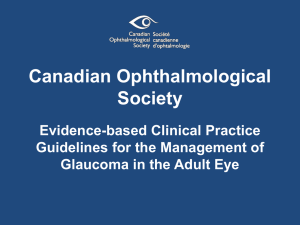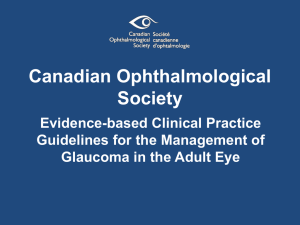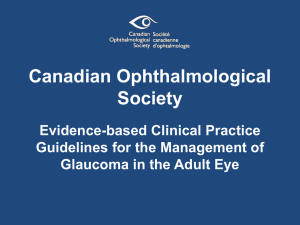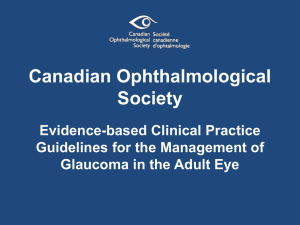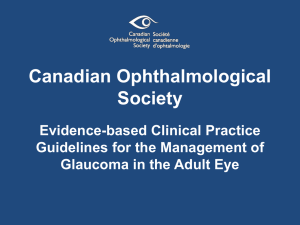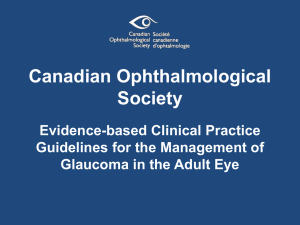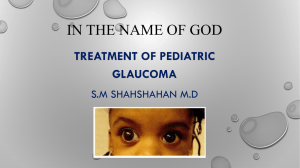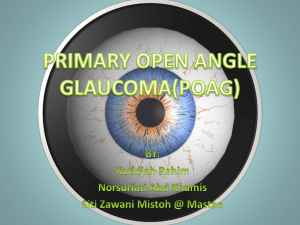Therapeutic principles and target IOP
advertisement
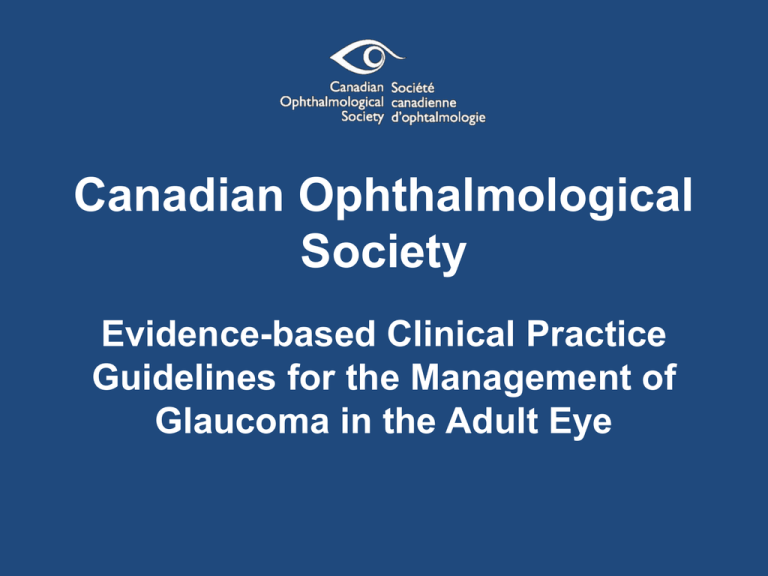
Canadian Ophthalmological Society Evidence-based Clinical Practice Guidelines for the Management of Glaucoma in the Adult Eye Glaucoma Therapies Overarching and specific management goals • • • • Preserve visual function. Maintain or enhance overall health-related QOL. Slow or halt progression of the disease. Achieved through a careful process of: – observing and monitoring visual function, – providing patient education and support, – providing medical, laser, and (or) surgical intervention as appropriate, and – observation without treatment in some cases. Canadian Ophthalmological Society evidence-based clinical practice guidelines for the management of glaucoma in the adult eye. Can J Ophthalmol 2009;44(Suppl 1):S1S93. Quality-of-life considerations • Glaucomatous field damage adversely affects the patient’s QOL.1,2 • Patients with glaucoma report: – Difficulties with bright lights and with light and dark adaptation.3 – Worry or concern about the possibility of blindness. – Difficulty with mobility (falls and motor vehicle accidents).1,4 – A negative impact associated with the therapy itself. 1. Noe G, et al. Clin Experiment Ophthalmol 2003;31:482–6. 2. Altangerel U, et al. Curr Opin Ophthalmol 2003;14:100–5. Canadian Ophthalmological Society evidence-based clinical 3. Janz NK, et al. Ophthalmology 2001;108:887–97. practice guidelines for the management of glaucoma in the 4 .Haymes SA, et al. Invest Ophthalmol Vis Sci adult eye. Can J Ophthalmol 2009;44(Suppl 1):S1S93. 2007;48:1149–55. Overall and specific management goals in patients with glaucoma • Preserve visual function by slowing or halting progression of disease • Maintain or enhance health-related QOL Specific goals • Set individualized target IOP for each eye • Observation or IOP lowering to achieve target IOP with one or more of medicine, laser, surgery • Minimize the side effects of treatment and its impact on the patient’s vision, general health, and QOL • Reverse or prevent angle closure process if applicable • Preserve the structure and function of the optic nerve • Vision enhancement/rehabilitation as indicated • Educate and empower patients so they are active participants in their vision health • Achieve sustainable cost for the patient • Optimal utilization of human, information technology, and other resources Overall goals Canadian Ophthalmological Society evidence-based clinical practice guidelines for the management of glaucoma in the adult eye. Can J Ophthalmol 2009;44(Suppl 1):S1S93. Lowering IOP and Setting Target IOP Lowering IOP • IOP lowering is the only clinically established method of treating glaucoma. • The effectiveness of IOP lowering has been established in several well-designed prospective RCTs.1-4 1. AGIS Investigators. Am J Ophthalmol 2000;130:429–40. 2. Collaborative Normal-Tension Glaucoma Study Group. Canadian Ophthalmological Society evidence-based clinical Am J Ophthalmol 1998;126:487–97. practice guidelines for the management of glaucoma in the 3. Heijl A, et al. Arch Ophthalmol 2002;120:1268–79. adult eye. Can J Ophthalmol 2009;44(Suppl 1):S1S93. 4. Chauhan BC, et al. Arch Ophthalmol 2008;126:1030–6. Lowering IOP (cont’d) • Reducing fluctuation in IOP (diurnal and (or) intervisit) may also be a worthwhile objective in select patients, such as those with: – advanced glaucoma, or – disease progression despite seemingly good IOP control, and – PXF glaucoma.1,2 1. AGIS Investigators. Am J Ophthalmol 2000;130:429–40. 2. Asrani S, et al. J Glaucoma 2000;9:134–42. Canadian Ophthalmological Society evidence-based clinical practice guidelines for the management of glaucoma in the adult eye. Can J Ophthalmol 2009;44(Suppl 1):S1S93. Setting target IOP • Formulation of target IOP is one of the most important steps in treatment. • Target IOP is defined as the upper limit of a stable range of measured IOPs deemed likely to retard further optic nerve damage.1 1. American Academy of Ophthalmology. Primary Canadian Ophthalmological Society evidence-based clinical Open-Angle Glaucoma. Preferred Practice Pattern. San Francisco, CA: American Academy practice guidelines for the management of glaucoma in the adult eye. Can J Ophthalmol 2009;44(Suppl 1):S1S93. of Ophthalmology; 2005. Setting target IOP (cont’d) • When setting target IOP, each eye is staged into 1 of 4 severity groups — suspect, early, moderate, or advanced glaucoma — based on: – – – – – – – assessment of the optic nerve and (or) VF patient factors age life expectancy QOL risk factors for progression patient’s own input • There is a fine line between setting an appropriate goal to prevent optic nerve damage, and being overly aggressive in IOP lowering. Canadian Ophthalmological Society evidence-based clinical practice guidelines for the management of glaucoma in the adult eye. Can J Ophthalmol 2009;44(Suppl 1):S1S93. Staging each eye for glaucoma damage Suspect One or two of the following: IOP >21 mm Hg; suspicious disc or C/D asymmetry of >0.2; suspicious 24-2 (or similar) VF defect Early Early glaucomatous disc features (e.g., C/D* <0.65) and (or) mild VF defect not within 10° of fixation (e.g., MD better than –6 dB on HVF 24-2) Moderate Moderate glaucomatous disc features (e.g., vertical C/D* 0.7–0.85) and (or) moderate VF defect not within 10° of fixation (e.g., MD from –6 to –12 dB on HVF 24-2) Advanced Advanced glaucomatous disc features (e.g., C/D* >0.9) and (or) VF defect within 10° of fixation† (e.g., MD worse than –12 dB on HVF 24-2) Adapted from Damji KF, et al. Can J Ophthalmol 2003;38:189–97. *Refers to vertical C/D ratio in an average size nerve. If the nerve is small, then a smaller C/D ratio may still be significant; conversely, a large nerve may have a large vertical C/D ratio and still be within normal limits. †Also consider baseline 10-2 VF (or similar). Canadian Ophthalmological Society evidence-based clinical practice guidelines for the management of glaucoma in the adult eye. Can J Ophthalmol 2009;44(Suppl 1):S1S93. Suggested upper limit of initial target IOP for each eye Stage Suspect in whom a clinical decision is made to treat Early Moderate Advanced Suggested upper limit of target IOP. Modify based on longevity, QOL and risk factors for progression 24 mm Hg with at least 20% reduction from baseline Evidence 20 mm Hg with at least 25% reduction from baseline 17 mm Hg with at least 30% reduction from baseline 14 mm Hg with at least 30% reduction from baseline EMGTS CIGTS CNTGS AGIS AGIS Odberg OHTS EGPS Adapted from Damji KF, et al. Can J Ophthalmol 2003;38:189–97. Note: Target IOP may need to be adjusted during the course of follow-up. Extremes of CCT may be helpful in the setting of target IOP. For example, if the cornea is very thin, this may encourage a more aggressive approach with more frequent follow-up. Canadian Ophthalmological Society evidence-based clinical practice guidelines for the management of glaucoma in the adult eye. Can J Ophthalmol 2009;44(Suppl 1):S1S93. Staging severity of glaucoma Recommendation Stage each eye of the patient as normal, suspect, early, moderate or advanced glaucoma based on optic nerve and (or) VF exam [Consensus]. Canadian Ophthalmological Society evidence-based clinical practice guidelines for the management of glaucoma in the adult eye. Can J Ophthalmol 2009;44(Suppl 1):S1S93. Target IOP — setting initial range Recommendation Set upper limit of initial target IOP range for each eye at first visit and then re-evaluate at each visit based on stability/change in structure and function of the optic nerve (i.e., ONH exam with or without additional imaging information as well as VF data) [Consensus]. Canadian Ophthalmological Society evidence-based clinical practice guidelines for the management of glaucoma in the adult eye. Can J Ophthalmol 2009;44(Suppl 1):S1S93.

